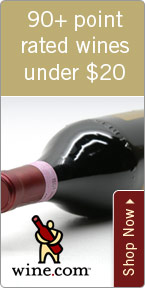The Sweet Pleasure Of Icewine

Wednesday - September 15, 2006
| Share
 Del.icio.us
Del.icio.usIcewine is one the great “labors of love” in the wine world. I was reminded of it last week when I had a chance to taste some of the sweet liquid treat. I had always known how hard it is to make icewine and how expensive it can be, but I was also surprised at its food compatibility when I sat down to a meal with it.
Icewine originated in Germany in the 1700s. Germany is a cool climate grape-growing region, and presumably when one winemaker serendipitously left the grapes on the vine too long into the winter months and the grapes were actually frozen when they were harvested, eiswein (German for icewine) was born.
Making wine out of frozen grapes is no simple matter of temperature. First the grapes must be ripe and healthy, without any signs of rot. The grapes must then be left on the vine for much longer than any other grapes, into the cold winter months. The winter months are quite harsh on the wildlife, too. And so without much to eat, deer, fox and bear are happy to eat sweet berries in the cold, reducing the yields of these vineyards. This is presuming that the cold is adequate to freeze your grapes. By law, the grapes must reach -8 degrees Celsius or just under 18 degrees Fahrenheit.
Did I mention that they must be hand-harvested, too? Can you imagine being out in the frigid cold picking these frozen bunches with your fingers?! You then have to take these frozen grapes and press them before they thaw. Top producers such as Inniskillin in Canada actually bring the wine press, a very strong one, something that can crush ice, out into the vineyards to press the grapes. There are some that use the artificial practice of cryo-extraction, actually harvesting the grapes as normal then freezing them in the winery. That process results in a wine whose quality is nowhere near that of true icewine.
As you can imagine, there is not a lot of juice that comes out of a frozen grape. What’s happening here is that water freezes at a higher temperature than acid and sugar. So what actually drips out of the press in minute quantity is an ultra-concentrated syrup-like liquid. And what is left in the press are all the skins, pits and ice. This liquid is then fermented up to anywhere between 9 and 11 percent alcohol. This lower alcohol level leaves an enormous amount of residual sugar in the wine that makes it delectably sweet.
But as sweet as these wines are, they have plenty of acidity to keep them balanced. In addition, these sugary elixirs age almost indefinitely. Even when the bottle is opened, it lasts much longer than any dry wine - three-four weeks vs. two-three days respectively.
The wines themselves are some of the greatest dessert wines in the world. They smell of honey, flowers, glacee fruits, jams and fruit preserves. They are truly dessert sweet, but are elegantly balanced and the flavors stay in your mouth for minutes at a time. With such sweetness and intensity, it is natural for people to think it only goes with dessert or foie gras. But I found that icewine also goes great with misoyaki butterfish, curry and even sushi! The sweetness counteracts the wasabi and the acidity cuts the fattiness of the fish.
German eiswein is an awesomely rare and complex treat that has few equals. But they are also some of the most expensive wines in the world because of their rarity.
Canada has also built a well-deserved tradition and reputation for making awesome icewines. They are able to make them in almost every year. They make such terrific icewines that rival and surpass those of Germany and at a fraction of the price.
If you’ve never tried one of these fabulously luscious wines, you owe it to yourself to experience all the juiciness, ripeness and pleasure that is in every bottle. It doesn’t matter if you’re in cold Canada or in balmy Hawaii, icewines are so exotic and sweet they are the perfect end to any meal.
Not to be left out in the cold: 2004 Jackson Triggs Vidal Icewine ($24/375ml) this wine makes your lips smack and brain tingle. Delectable and so easy to drink.
2003 Inniskillin Vidal Gold Icewine ($89/375ml) this is an oak-aged version that has even more depth and richness. Like liquid crème brulee and marmalade. Explosive!
Roberto Viernes is a master sommelier. E-mail .(JavaScript must be enabled to view this email address)E-mail this story | Print this page | Comments (0) | Archive | RSS Comments (0) |
Most Recent Comment(s):












